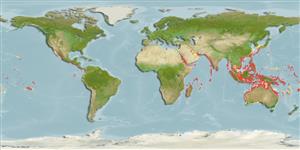Common names from other countries
>
Eupercaria/misc (Various families in series Eupercaria) >
Labridae (Wrasses) > Corinae
Etymology: Halichoeres: Greek, als, alis = salt + Greek, choiros = pig (Ref. 45335).
More on author: Bennett.
Environment: milieu / climate zone / depth range / distribution range
экология
морской ассоциированный с рифами; пределы глубины 10 - 40 m (Ref. 90102). Tropical
Indo-West Pacific: Persian Gulf (Ref.80050); Red Sea and the Gulf to Samoa, north to southern Japan, south to the Great Barrier Reef (Ref. 9710). Western Indian Ocean: Mozambique (Ref. 41878).
Size / Вес / Возраст
Maturity: Lm ? range ? - ? cm
Max length : 20.0 cm TL самец/пол неопределен; (Ref. 9710)
Краткое описание
определительные ключи | морфология | морфометрия
колючие лучи спинного плавника (общее число) : 9; членистые (мягкие) лучи спинного плавника (общее число) : 11; колючие лучи анального плавника: 3; членистые (мягкие) лучи анального плавника: 11. Females light bluish gray dorsally, white ventrally, with a narrow orange stripe running from the top of the snout to the upper base of the caudal fin (where it may contain a blackish spot). Males blue-green on head and anterior portions of the body with irregular pink band and spots; their orange-yellow lateral stripe blue-edged, often with narrow extensions; a blue-edged spot at the upper portion of the pectoral fin base, and two or more similar blue-edged spots just anterior of the caudal peduncle above the lateral stripe.
Inhabits open sand and rubble areas of seaward reefs, to depths greater than 34 m (Ref. 9710). Usually in small groups of females with single males patrolling the area (Ref. 48636).
Life cycle and mating behavior
Maturities | размножение | Spawnings | Egg(s) | Fecundities | личинки
Distinct pairing during breeding (Ref. 205).
Randall, J.E., G.R. Allen and R.C. Steene, 1990. Fishes of the Great Barrier Reef and Coral Sea. University of Hawaii Press, Honolulu, Hawaii. 506 p. (Ref. 2334)
Статус Красного Списка МСОП (Ref. 130435)
CITES (Ref. 128078)
Not Evaluated
Угроза для людей
Harmless
Использование человеком
рыболовство: коммерческий; аквариум: коммерческий
дополнительная информация
инструменты
Специальные отчеты
Скачать в формате XML
ресурсы в Интернет
Estimates based on models
Preferred temperature (Ref.
115969): 24.6 - 29.1, mean 27.9 (based on 750 cells).
Phylogenetic diversity index (Ref.
82804): PD
50 = 0.5000 [Uniqueness, from 0.5 = low to 2.0 = high].
Bayesian length-weight: a=0.00977 (0.00563 - 0.01695), b=3.15 (3.00 - 3.30), in cm Total Length, based on LWR estimates for this species & Genus-body shape (Ref.
93245).
Trophic level (Ref.
69278): 3.5 ±0.5 se; based on size and trophs of closest relatives
устойчивость к внешним воздействиям (Ref.
120179): средний (среднего размера), минимальное время удвоения популяции 1.4-4.4 года (Preliminary K or Fecundity.).
Fishing Vulnerability (Ref.
59153): Low vulnerability (10 of 100).
